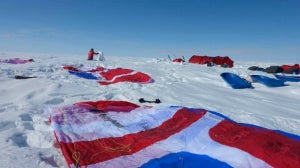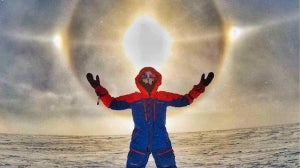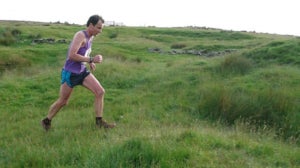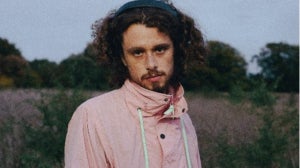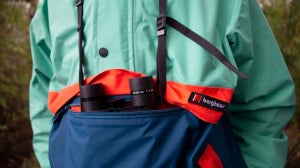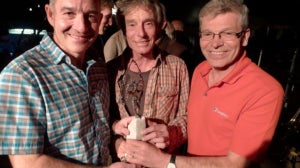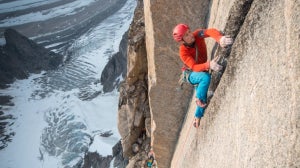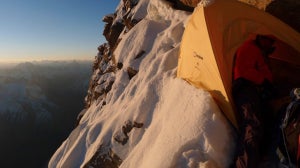
Appalling weather conditions have foiled Mick Fowler and Victor Saunders during their latest Himalayan expedition. After a cancer diagnosis for Mick had delayed his long-held dream to climb the mountain, he set out with Vic on a trip sponsored by Berghaus, to attempt a first ascent of Chombu, a 6,362m peak in the Sikkim Himalaya, India.
Unfortunately, on arrival in the remote area where the Chombu mountain is located, they were met with the aftermath of what locals claimed were the heaviest winter snowfalls since 1995, and then by persistent fresh snow and warm conditions at base camp, and the attendant high risk of avalanches.
Below, Mick gives his account of the attempt at Chombu.
“My hotel is broken”
Victor Saunders and I had arrived in the small village of Tanggu where we were to spend the night en route to attempt Mt Chombu in Northern Sikkim.
The object of our desires. Chombu from near the Sebu La pass
The hotel owner’s tour of his hotel left us in no doubt that he was not exaggerating. Like 20% or so of the buildings in Tanggu, it was indeed very broken.
‘Seven feet of snow in one storm’ announced a bystander.
‘Heaviest winter snow since 1995’ added another.
We had been warned that the winter snows had been heavy but nothing had quite prepared us for tree trunk strewn avalanches across the road and the damage to property. Clearly we were faced with unusually challenging conditions. I made a mental note to spring into clearing action if seven feet of snow should ever look like falling on my roof in the UK.
Sikkim was a new area for both of us and the deep, jungle covered, winding valleys of the foothills made for a grand and varied approach to the mountains of the north. Our approach was along the ‘short route’ followed by the Everest pioneers of the 1920s. ‘Short’ is of course a relative term. In the days before motorised transport the 1921 Everest team took 36 days to walk from Darjeeling to their base camp. The perseverance and commitment of those pioneers in just getting to and from the mountain was remarkable. It was almost enough to make me feel guilty that the approach to our base camp involved ‘only’ flying to Bagdogra, two days of driving to Tanggu and two days of walking.
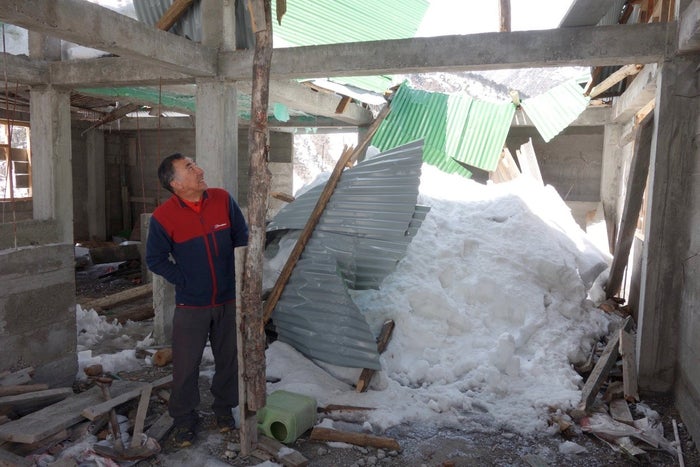
Winter snow damage at our hotel in Tanggu.
Much as transport has improved in leaps and bounds since the early Everest days the administrative challenges of climbing in the Himalaya are often as challenging now as they were then. Today almost all the Himalayan countries require those attempting significant mountains to secure bespoke permits and employ a Liaison Officer, a cook and a kitchen boy at the very least. This can be time consuming, expensive and certainly puts people off. In calm moments I celebrate the fact that this shield of bureaucracy has ensured that many fine mountains remain unclimbed – but when caught up in the frequent last minute stress and uncertainty of officialdom I tend not to be quite so appreciative of the administrative challenges.
Partially because of the difficulties, expense and uncertainty involved in securing all the necessary permissions the climbing history of Chombu is relatively short. Bad weather and soft snow stopped Cooke and McPherson in 1944. Doug Scott’s team experienced much the same problem in 1996 as did Roger Payne and Julie-Ann Clyma in 2007. A widely discredited first ascent claim was made in 1961 but the highest point, still a long way from the summit, had been reached by a Japanese team in 1992.
“Your flights have been cancelled”
Noting the recurring mention of soft snow problems, our plan was to attempt the west face which we judged was steep enough to not hold snow and therefore give the kind of move-one-at-a-time mixed climbing that Victor and I prefer. Our plan was to go in the post monsoon (September/October) season of 2017 although when we first started planning in 2016, we could never have dreamed that so many hurdles would arise. Firstly, after an initial failure at the first administrative hurdle, permits were granted for post monsoon 2017 but then withdrawn as a result of a border skirmish with China.
Then, out of the blue, I was diagnosed with cancer of the anus. Pre-monsoon 2018 was spent recovering from radiotherapy, that treatment failed and post-monsoon 2018 was spent recovering from an operation to cut out my anus and rectum. And so it wasn’t until pre-monsoon 2019 that health and permits issues came positively together and we were finally ready to go. After all the delays, hassle and stress it seemed almost ironic that an email from Jet Airways provided the final hurdle. The message was laughably direct if not welcome.
‘Dear Customer, Your flights have been cancelled. We apologise for any inconvenience. Alternatives are listed below.’
The blank space below said it all.
Take 1, 2, 3…
It felt a huge relief when Victor and I finally managed to re-book and arrive in Sikkim. And even more of a relief to finally battle our way through the snow drifts and avalanche debris to arrive at Tanggu.
Our team to walk in to base camp consisted of the two of us, four sherpas, a cook, a kitchen boy and five porters. There was also a Liaison Officer who returned to Gangtok after ensuring we were underway. It felt an awful lot of people to support a lightweight two man team.
Finding enough porters had been tricky. The local people were much more interested in searching for caterpillar fungus (much in demand in China as an aphrodisiac and cure to most ailments known to man) than portering and the net had to be cast far and wide. The end result was five outrageously strong young men being brought in from Darjeeling. Being as there were so few it was just as well that they were so strong.
The triple loads that they shouldered must have weighed 70Kg and matched the heaviest I have ever seen. Unfortunately this meant that, as the day progressed, and the snow softened they sunk in ever more deeply. The snow really was a problem and we were only able to make progress at all because the track stuck to the south facing side of the valley where the winter snows were starting to thin out. The north side looked a lot like the alps after a heavy winter snow fall.
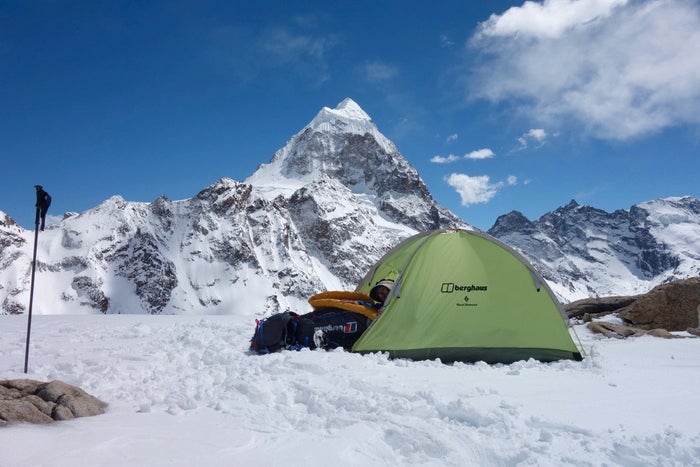
The track on the south side was interesting. In the sections that were not completely snow covered it could be seen that it had been carefully made up with rocks cemented into place in a parallel sided tour de force. Later, when the snows had largely melted, we were to discover that this amazing track did a loop of the valley stretching up to a point only 30 minutes or so from our base camp. We never did get a clear explanation for its existence. Suggestions that it was built for military purposes or to take yaks up to a yak racing ground were dismissed in favour of it being some kind of tourist trail. Either way it would have been very useful had it not been largely covered in snow.
It took two days and several ferries before we set up base camp by an idyllic stream 30 minutes short of the old Himalayan Club hut at the foot of the Sebu La. This pass connects the Lachen and Lachung valleys and back in the days of British control it was a sufficiently popular crossing for the Himalayan Club to judge it worth building a substantial hut either side. Nowadays permits to visit are hard to come by and the remains of the hut crumble quietly in summer yak grazing grounds.
From the Himalayan Hut, it could be seen that, in sharp contrast to virtually everywhere else, the mountain was surprisingly devoid of snow. It did though look distressingly exciting with uncompromisingly steep slopes leading up to an enticing curling summit snow ridge. I almost felt quite emotional finally seeing the object of my dreams for the last three years.
“Acclimatizing”
I find acclimatizing the least exciting part of a Himalayan trip. For me it involves getting up to an altitude around 1,000m short of the intended summit and then lying there holding my head for three or four nights before heading down to base camp where I spend a day eating lots of food before starting the fun bit – the climb. At least on this occasion we had four bored and willing sherpas to help us break trail and carry kit. Quite why we had four I wasn’t sure.
At one point it seemed that they had been expecting to fix ropes and stock camps for us but another time we were told it was mandatory to have four. Whatever the reasoning their trail breaking ability was much appreciated as we plodded around soaking in 5,000m air, charting lines up the west face and visiting the Sebu La pass to get a view of our preferred descent route. Curiously the way to the pass was marked by an old electric cable which appeared to run from the Himalayan Club hut right the way over the pass.
We climbed an easy 5,600m summit on the watershed, spent a couple of days and nights lying at 5,500m sucking in thin air and, in perfect weather, scrunched down well frozen snow to our base camp in high spirits. We had chosen our line, the weather looked good and all we had to do now was spend a day eating and then start climbing. Life was good.
By the next morning 10cm of snow had fallen, the temperature was hovering around freezing and base camp was in the cloud. Another day of eating was judged appropriate – we had a time cushion of about a week so could afford to be relaxed and wait out some bad weather. The next day dawned the same but, feeling the need to be in position at the foot of our intended line, we trudged up through the falling snow, pitched our little tent at the foot of the face and set the alarm for an early start. But the weather would not play ball. In the early hours it was still snowing and the temperature was clearly too warm for a good freeze. The days passed with little change. The boredom level grew. There is only so much time that can be spent in a two man tent without going stir crazy.
Waiting for ‘summit’
This year’s reading material was unusual in that it had been sent to me by a long standing climbing partner of mine, Crag Jones. Doubtless reeling from my frequent abuse for his choosing Stephen Hawking’s ‘Brief History of Time’ on one of our trips together he had taken it upon himself to send me two books for this trip. Barbara Cartland made it to the foot of the route but I’m afraid ‘A short history of the Industrial Revolution’ failed to leave the UK. Sorry Crag! By day three at the foot of the face I had read Barbara Cartland for the second time. Somehow though I didn’t seem to have missed much the first time. Meanwhile Victor busied himself with Wade Davis’s 650 page monster ‘Into the Silence’ which he was kind enough to tear up and hand to me as he finished each chapter. In between reading and brewing we stared at the ceiling, righted the wrongs of the world and discussed the pros and cons of colostomy bags on constricted bivouacs.
A small tent was not the harshest of testing grounds but my experience thus far suggested that all would be well on the more difficult bivouacs. In fact having control over when to empty the bag could even be an advantage – no urgent exits into spindrift laden nights for me. Victor, who had a nasty incident of being caught short on our last Himalayan climb together, looked mildly envious without going so far as to wish he could have the operation. In fact though the trickiest problem for me was not being able to sit down properly. The operation had involved plastic surgery across both buttocks and much as well cushioned sitting is bearable a sitting bivouac would require very careful planning. With endless hours to waste we whiled away the time discussing laughable possibilities interminably.
But the weather wasn’t getting any better. Every morning would be sunny and hot, the snow would melt and we would dream of a safe, frozen surface for the following morning. And then, come 3pm or so, the snow would start again and continue right through until 6am or so. By then 10 cm or so would have fallen, the avalanche risk would be high and the underlying snow would be insulated by the new fall and not freeze. One day only 3cm fell and stars were visible. Excitement mounted. We sprang into action and got out of the tent. But then heavy wet snow started and we sank knee deep in unfrozen snow. Ugh! It was both dangerous and unpleasant such that a return to our sleeping bags was deemed appropriate. Despondency levels were rising but all we needed was one good day to get started. Food ran short and we waded down to base camp and back up with fresh supplies. This ensured full stomachs but had no effect on the weather pattern. All in all it developed into the most frustrating wait that either of us had ever experienced.
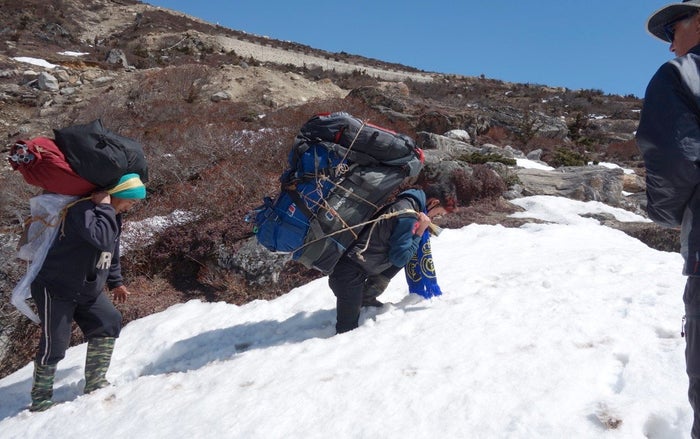
Wellies, 70Kg loads and soft snow. A bad combination.
“Have we been beaten?”
Gradually all reading material had been read, all conversation topics exhausted and it became increasingly clear that there was a growing possibility that the main achievement of the British Chombu Expedition might be to wander around testing Berghaus kit in harsh weather conditions.
Immediately across the glacier from the west face of Chombu was a 5,322m peak at the end of a ridge line stretching north from Chungukang. Chungukang North, as we grandly christened it, was insignificant compared to Chombu but it was probably unclimbed and we had reached the stage where exercising and getting to any summit was preferable to continuing to lie unproductively in a small tent.
Our sherpas had been keeping a close eye on what we were up to and Pasang and Subas, the two youngest and most energetic, were keen to join us. The four of us trudged through enervating knee deep snow and gained the south ridge via a bottomless unfrozen snow slope which was every bit as bad as we had anticipated. Pasang and Subas raced ahead in the morning sun while Victor and I plodded along in their steps stopping frequently to look over our shoulders at the untrodden slopes of Chombu behind us. The ridge, when we reached it, was mainly moderate rock climbing and led enjoyably to the summit as the afternoon clouds began to build.
By 4pm it was sleeting hard and visibility was zero. The British Chombu Expedition trudged forlornly back to base camp.
Chombu had beaten us. Sometimes things don’t go according to plan. But we had seen first hand what a special mountain it is.
And we have a plan. We will be back.


